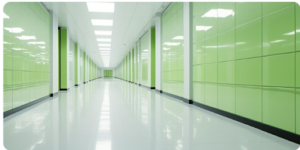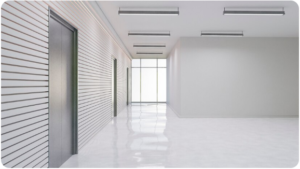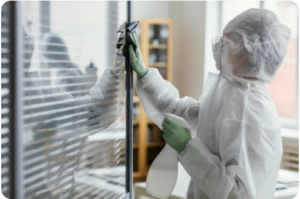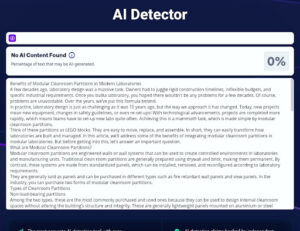A few decades ago, laboratory design was a massive task. Owners had to juggle rigid construction timelines, inflexible budgets, and specific industrial requirements. Once you had built a laboratory, you hoped there wouldn’t be any problems for a few decades. Of course, problems are unavoidable. Over the years, we’ve put this formula behind.
In practice, laboratory design is just as challenging as it was 10 years ago, but the way we approach it has changed. Today, new projects mean new equipment, changes in safety guidelines, or even re-set-ups! With technological advancements, projects are completed more rapidly, which means teams have to set up new labs quite often. Achieving this is a mammoth task, which is made simple by modular cleanroom partitions.
Think of these partitions as LEGO blocks. They are easy to move, replace, and assemble. In short, they can easily transform how laboratories are built and managed. In this article, we’ll address some of the benefits of integrating modular cleanroom partitions in modular laboratories. But before getting into this, let’s answer an important question.
Modular Cleanroom Partitions 101: What They Are & Why They Matter
Modular cleanroom partitions are engineered walls or wall systems that can be used to create controlled environments in laboratories and manufacturing units. Traditional clean room partitions are generally prepared using drywall and brick, making them permanent. By contrast, these systems are made from standardised panels, which can be installed, removed, and reconfigured according to laboratory requirements.
They are generally sold as panels and can be purchased in different types, such as fire-retardant wall panels and view panels. In the industry, you can purchase two forms of modular cleanroom partitions.
Types of Cleanroom Partitions
-
Non-load-bearing partitions
Among the two types, these are the most commonly purchased and used ones because they can be used to design internal cleanroom spaces without altering the building’s structure and integrity. These are generally lightweight panels mounted on aluminium or steel frames and are commonly used in areas where the ceiling and building shell provide support; you only need to break the internal space. They’re commonly used in Class 100,000–10 cleanrooms and are cheap, allowing frequent layout changes.
-
Load-bearing partitions
On the other hand, load-bearing partition systems are engineered to support overhead structures like ceilings, mechanical systems, and air handling units. Naturally, they’re stronger than non-load-bearing systems. They are used when designing multiple-level cleanroom systems or if filtration machines need to be integrated immediately above the cleanroom. They’re commonly used in pharmaceutical production, where HVAC units are installed overhead.
Both load-bearing and non-load-bearing partition systems can be used depending on the application requirements. Many companies in diverse industries have opted for modular partition systems because of their advantages.
5 Game-Changing Benefits of Modular Cleanroom Walls for Fast-Moving Labs
Today, modular cleanroom partitions aren’t just a design option; they’re strategic upgrades for labs. Here are some of the advantages encouraging cleanroom and laboratory designers and constructors to choose modular cleanroom partitions:
1. Speed Without Sacrificing Standards
Because they’re compliant with various international standards, including ISO, GMP, and FDA, and because they can be easily moved, modular partitions can decrease construction time without compromising on cleanroom standards. The stringent pre-fabrication guidelines ensure the prepared materials are high-precision and easy to install.
2. Excelling in Flexibility
Your research space needs to evolve with your research project, and modular systems are perfect for the job! They can be expanded and relocated without breaking a sweat, which makes them perfect for labs with evolving workflows such as R&D hubs and multi-product production facilities.
3. Zero Downtime
What’s one drawback of building labs? The downtime. You have to take a break from research while the lab is being built. Not anymore! These systems allow partial installation, which is also completed very quickly. For example, you can completely redesign your laboratory overnight and make the changes in a few hours, which means you won’t fall back on your timelines because of downtime!
4. Cheaper in the Long Run
Yes, the upfront purchasing costs are quite high, but you will save a lot of money with these systems. Here’s how: When you think of designing a lab in a given space, you’ll have to add the designer’s costs, labour charges, and material charges. But here’s what you’re missing: Maintenance charges, waste, and renovation expenses. With modular cleanroom partitions, you don’t have to account for these. Their reusability and durability mean you need to spend only once, allowing better ROI over the facility’s lifetime.
5. More safety and cleanliness
Modular partitions are made with FDA, GMP, and ISO guidelines in mind. This means they don’t create contaminant, dust, and noise risks, which you’ll usually face with traditional construction. Consequently, they create sterile environments that support cleaner commissioning and regulatory audits.
These five advantages are why modular cleanroom partitions are being integrated into various modern labs. However, there are many companies that still opt for traditional partitions. While traditional partitions have advantages, they fall just short of modular partitions
What’s Making Modular Cleanroom Partitions Better than Traditional Partitions?
Here’s the answer:
1. They are easier to install.
Traditional partitions require a lot of planning because, ultimately, you’re constructing with drywall and brick. By contrast, modular systems are pre-engineered and pre-fabricated; you only need to purchase and install, reducing installation time.
2. They allow your lab to remain flexible.
Once you’ve built a traditional partition, there’s no going back–unless you’re ready to break down walls (literally!) and get in a construction crew. But with modular partitions, things are a little more flexible. You can disassemble the panels and store them if not needed, and then reinstall and use them when needed. This is especially ideal for labs that are undergoing frequent updates or are used to prepare several products at once.
3. They won’t stop your research.
Building traditional partitions generates a lot of dust and dirt. So, once the build is complete, you need to thoroughly clean the area to ensure the cleanroom is once again sterile. This increases the downtime of the facility. But you don’t face this problem with modular cleanroom partitions. Because they’re pre-fabricated, they allow non-invasive upgrades while generating minimal dust.
-
You don’t have to invest in compliance!
With traditional partitions, you have to jump through many hoops to get the area compliant again. But this isn’t the case with modular systems. They’re manufactured to comply with GMP standards and FDA guidelines. You can also purchase ISO 14644-1 compliant modular systems, which means you don’t have to undergo further processes to get validated and documented.
-
They have integrated options.
With traditional partitions, you need to individually plan and install all your requirements. But with modular partitions, many options come built-in. For example, Shree Vishwakarma’s fire retardant panels mean you don’t have to invest in integrating additional anti-fire measures, and their return air riser panels mean you need not integrate additional air suction measures. Such options make it easy to design and create cleanrooms.
Is This Really a Big Deal?
Imagine this: Your team has developed an initial formulation for cancer. Now, you need to test this product on cell lines, but before moving to the next step, you need to reconfigure your lab so that it matches the GMP guidelines for live testing. The contractor quoted six weeks. For your lab, it means six weeks of delay, which can be the difference between being the first team to launch this product or the second.
Is there an alternative? Yes. Those modular partitions. You can simply reconfigure them over the weekend and continue work from Monday.
Stress? Reduced.
Dust? Reduced.
Timeline? Reduced.
Chances of being the first? Definitely higher!
What Should You Keep In Mind?
As with all things cleanroom, you need to find a reliable supplier. Find cleanroom suppliers and developers who manufacture high-quality, compliant cleanroom equipment and supplies. To this end, Shree Vishwakarma Alu Projects Pvt. Ltd. can help you. We manufacture a range of complaint cleanroom partitions that can be used in pharmaceutical, engineering and R&D labs. We’re ready to help you find the perfect cleanroom equipment. Are you? Contact us now to get started.






